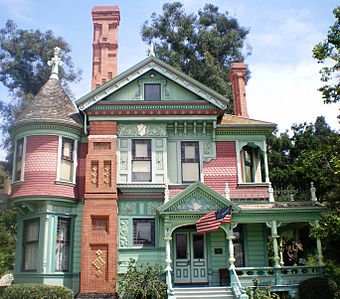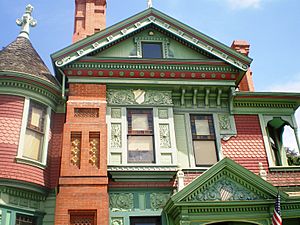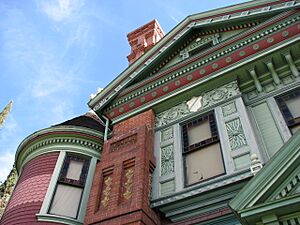Hale House (Los Angeles, California) facts for kids
|
Hale House
|
|

Hale House, 2008
|
|
| Location | Heritage Sq., 3800 N. Homer St., Highland Park, Los Angeles, California |
|---|---|
| Built | 1887 |
| Architect | Joseph Cather Newsom |
| Architectural style | Queen Anne-Victorian |
| NRHP reference No. | 72000230 |
Quick facts for kids Significant dates |
|
| Added to NRHP | September 22, 1972 |
The Hale House is a beautiful old mansion built in 1887 in Highland Park, a part of Los Angeles, California. It's designed in a style called Queen Anne-Victorian, which was popular a long time ago. Many people say it's the "most photographed house" and the "most decorated" in the whole city!
It's so special that it was named a Historic-Cultural Monument in 1966 and added to the National Register of Historic Places in 1972. This means it's an important historical building. In 1970, the house was carefully moved to the Heritage Square Museum in Montecito Heights. Today, you can visit it there!
Contents
The House's First Years
The Hale House was designed by Joseph Cather Newsom, a famous architect from that time. It was built in 1887 by a real estate developer named George W. Morgan. The house was built at the bottom of Mount Washington.
It cost less than $4,000 to build, which was a lot of money back then! The house was first located at 4501 North Pasadena Avenue. It was later moved to 4425 North Pasadena before James G. Hale bought it. Some people think it was connected to the old Page School for Girls, which was right across the street.
James G. Hale and his new wife, Beret “Bessie” Hovelsrud, bought the house in 1901. James met Bessie, who was a farm girl from Nebraska, when she was working at the Pio Pico House. They fell in love, got married, and bought the Hale House to live in.
A few years later, the couple separated. James Hale passed away in 1921 at age 51. Bessie kept the house and ran it as a boarding house until the late 1950s. She lived there until she passed away in 1966 at the age of 97.
Moving to Heritage Square Museum
After Bessie Hale passed away, her niece, Odena Johnson, inherited the house. She wanted to sell it quickly. When plans were made to tear down the house and build a gas station, the Los Angeles Cultural Heritage Commission stepped in.
They stopped the demolition by declaring the house a Historic-Cultural Monument in 1966. A newspaper column by famous Los Angeles Times writer Jack Smith helped save the house. Smith called the "faded old house" one of the last remaining buildings from a lively time in history.
Smith explained that the house was "picturesque eclectic." This means its designer mixed different styles and decorations together in a fun way. He said the Hale House showed many architectural ideas from the late 1800s.
Hale's niece agreed to sell the house for just $1 if it could be moved. In July 1970, the house was lifted from its foundation and moved to the nearby Heritage Square Museum. The move cost $10,300, plus another $3,000 to lift power lines so the house could pass underneath.
Jack Smith, who had supported saving the house, watched it being moved at midnight. He wrote that a "motley and festive" crowd gathered to watch. People cheered when the chimneys made it through the move safely.
Soon after the move, the house was used as a movie set for a film about a house bombed in a war. Later, the house was carefully restored. This restoration cost more than $300,000.
What the House Looks Like
The Hale House has a mix of architectural styles. It's been called Queen Anne, Eastlake, Carpenter Gothic, and even "a capricious old gingerbread." Jack Smith heard a neighbor call it "a mishmuch," and he agreed, calling it "a wonderful old mishmuch."
No matter the exact style, the house is a great example of Victorian design. It has fancy brick chimneys, colorful stained-glass windows, detailed wood carvings, and a round "corner turret." This turret is topped with large copper fleur-de-lis decorations.
In 1966, Raymond Girvigian, an expert on historic buildings, described the house. He noted its wooden siding with "fish scale shingles" and plaster decorations around the windows. He also mentioned the porch with its carved wooden posts and the decorative iron railing on its roof.
Girvigian also pointed out the brick chimneys with their unique patterns. He said the house showed "exuberance in ornamentation," meaning it had lots of fun and creative decorations.
When the Cultural Heritage Commission named Hale House a historic monument, they gave these reasons:
- This beautiful building is a great example of the late Victorian period in Los Angeles.
- It shows the most typical features of this historical style in one place.
- The house has ornate wood carvings, both inside and out, which are becoming rare.
- The chimney is typical of grand city houses from that time.
- The craftsmanship is as good as the best mansions on old Bunker Hill.
During the house's restoration, small pieces of the original paint colors were found. The outside of the house, which is mostly pink and teal, was painted with these exact colors. The inside has been restored to look like it did in 1899, but many original features are still there.
For example, the "wainscoting" downstairs is original. It's called Lincrusta and is made of a pressed paper mixture that looks like embossed leather. The decorative door bracket in the front room and the dining table and chairs were bought by the Hale family. You can visit the Hale House and other old Los Angeles buildings at the Heritage Square Museum.
See also







